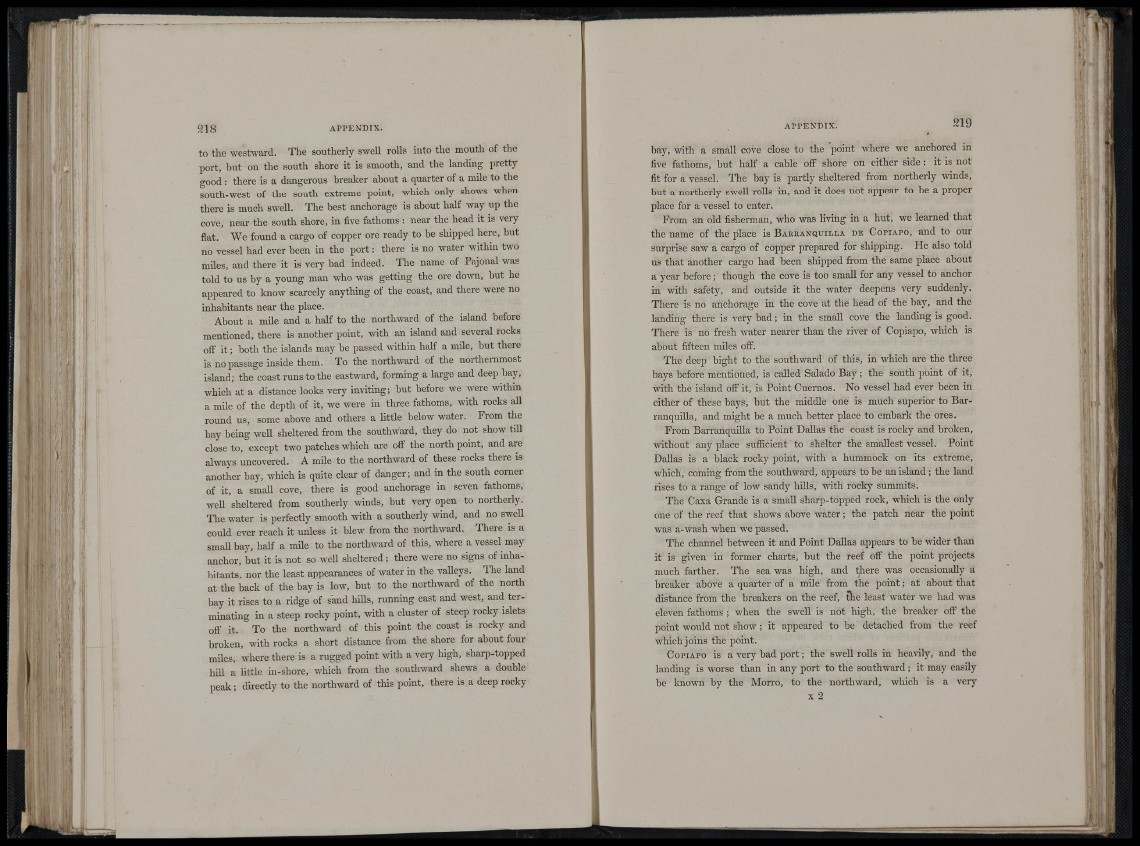
i;ti
1218 AtTENDIX.
to the westward. Tlie southerly swell rolls into the mouth of the
port, but on the south shore it is smooth, and the landing pretty
good : there is a dangerous breaker about a quarter of a mile to the
south-west of the south extreme point, which only shows when
there is much sweU. The best anchorage is about half way up the
cove, near the south shore, in five fathoms : near the head it is very
flat. We found a cargo of copper ore ready to be shipped here, but
no vessel had ever been m the port: there is no water within two
miles, and there it is very bad indeed. The name of Pajonal was
told to us by a young man who was getting the ore down, but he
appeared to laiow scarcely anything of the coast, and there were no
inhabitants near the place.
About a mHe and a half to the northward of the island before
mentioned, there is another point, with an island and several rocks
off it; both the islands may be passed within half a mile, but there
is no passage inside them. To the northward of the northernmost
island; the coast runs to the eastward, forming a large and deep bay,
which at a distance looks very inviting; but before we were within
a mile of the depth of it, we were in three fathoms, with rocks all
round us, some above and others a little below water. From the
bay being well sheltered from the southward, they do not show tiU
close to, except two patches which are off the north point, and are
always uncovered. A mUe to the northward of these rocks there is
another bay, which is quite clear of danger; and in the south comer
of it, a small cove, there is good anchorage in seven fathoms,
well sheltered from southerly winds, but very open to northerly.
ITie water is perfectly smooth with a southerly wind, and no sweU
could ever reach it unless it blew from the northward. There is a
small bay, haW a mile to the northward of this, where a vessel may
anchor, but it is not so weU sheltered; there were no signs of inhabitants,
nor the least appearances of water in the vaUeys. The land
at the back of the bay is low, but to the northward of the north
bay it rises to a ridge of simd hills, running east and west, and terminating
in a steep rocky pomt, with a cluster of steep rocky islets
off it. To the northward of this point the coast is rocky and
broken, with rocks a short distance fi-om the shore for about four
miles, where there is a rugged point with a very high, sharp-topped
hill a Uttle in-shore, which from the southward shews a double
peak; directly to the northward of this point, there is a deep rocky
APPENDIX. S19
bay, with a small cove close to the point where we anchored in
five fathoms, but half a cable off shore on either side: it is not
fit for a vessel. The bay is partly sheltered from northerly winds,
but a northerly swell rolls in, and it does not appear to be a proper
place for a vessel to enter.
From an old fisherman, who was living in a hut, we learned that
the name of the place is BABRAnauiiLA de Copiapo, and to our
surprise saw a cargo of copper prepared for shipping. He also told
us that another cargo had been shipped from the same place about
a year before; though the cove is too small for any vessel to anchor
in with safety, and outside it the water deepens very suddenly.
Tliere is no anchorage in the cove at the head of the bay, and the
landing there is very bad; in the small cove the landing is good.
ITiere is no fresh water nearer than the river of Copiapo, which is
about fifteen miles off.
The deep bight to the southward of this, in which are the tliree
bays before mentioned, is caUed Salado Bay; the south point of it,
with the island off it, is Point Cuemos. No vessel had ever been in
either of these bays, but the middle one is much superior to Barranquilla,
and might be a much better place to embark the ores.
From BarranquiUa to Point Dallas the coast is rocky and broken,
mthout any place sufficient to shelter the smallest vessel. Point
Dallas is a black rocky point, mth a hummock on its extreme,
which, coming from the southwai'd, appears to be an island; the land
rises to a range of low sandy hiUs, with roclcy summits.
The Caxa Grande is a small sharp-topped rock, which is the only
one of the reef that shows above water; the patch near the point
was a-wash when we passed.
The channel between it and Point Dallas appears to be wider than
it is given in former charts, but the reef off the point projects
much farther. The sea was high, and t^ere was occasionally a
breaker above a quarter of a mile fi om the point; at about that
distance from the breakers on the reef, tlie least water we had was
eleven fathoms ; when the swell is not high, the brealier oft" the
point would not show; it appeared to be detached from the reef
which joins the point.
Copiapo is a very bad port; the swell roUs in hea\nly, and the
landing is worse than in any port to the southward; it may easily
be known by the Morro, to the northward, which is a very
X 2
f
h
i f f
iti